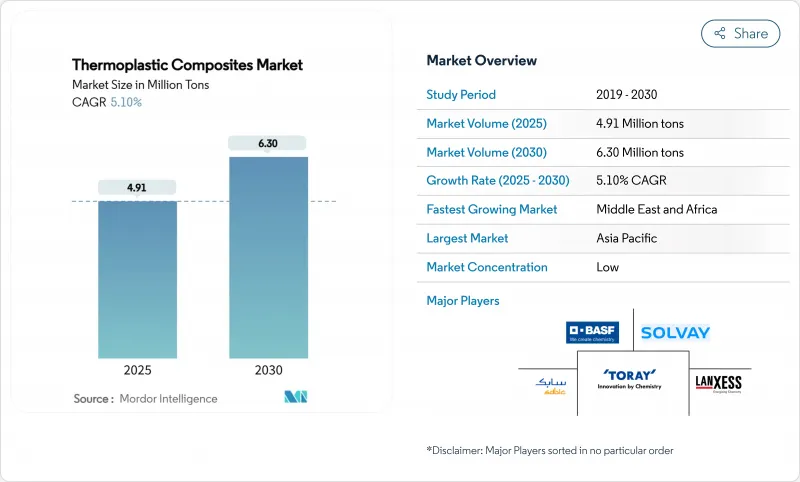
|
市場調査レポート
商品コード
1851631
熱可塑性複合材料:市場シェア分析、産業動向、統計、成長予測(2025年~2030年)Thermoplastic Composites - Market Share Analysis, Industry Trends & Statistics, Growth Forecasts (2025 - 2030) |
||||||
カスタマイズ可能
適宜更新あり
|
|||||||
| 熱可塑性複合材料:市場シェア分析、産業動向、統計、成長予測(2025年~2030年) |
|
出版日: 2025年07月01日
発行: Mordor Intelligence
ページ情報: 英文 120 Pages
納期: 2~3営業日
|
概要
熱可塑性複合材料市場規模は2025年に491万トンと推定され、予測期間(2025~2030年)のCAGRは5.10%で、2030年には630万トンに達すると予測されます。

この量的拡大は、2030年に予想される原料生産能力の3分の1以上が現在まだ設置されていないことを意味するため、迅速に規模を拡大できるメーカーは価格面で優位に立つことになります。リサイクル設計プログラムの並行的な増加は、この将来的な生産能力の一部が、グリーンフィールドの生産能力だけでなく、再生利用される流れからもたらされることを示しており、これは長期的なコスト曲線を総合リサイクル業者に有利に微妙にシフトさせる。地域と最終市場の分布は、二本立ての成長経路を示唆しています。すなわち、量はアジア太平洋の高スループット用途が主導する一方、価値と技術の主導権は北米と欧州の航空宇宙プログラムにあります。
世界の熱可塑性複合材料市場の動向と洞察
欧州と米国における急速な自動車の軽量化義務化
両地域のフリート平均排出ガス規制が強化され、乗用車から重量を10kg減らすごとに、相手先商標製品メーカー(OEM)の財政的な負担が大きくなっています。熱可塑性複合材料では、鋼鉄に対して30~40%の軽量化が可能であるため、複合材製のリーフスプリングやシートフレームを採用した中型車では、バッテリーの化学的性質を変えることなく、電気走行距離換算でおよそ15kmの距離を延長することができます。最近の設計スタジオからのフィードバックから新たに推測されるのは、複合材サブアッセンブリーの溶接が容易なため、プロトタイプのリードタイムが短縮され、モデル更新サイクルの高速化という予期せぬメリットがもたらされているということです。その結果、サプライチェーン・チームでさえも、規制遵守と市場投入までの時間短縮という2つのレンズを通して、軽量化を見ています。
Eモビリティにおけるリサイクル可能な複合材料ソリューションへのOEMの後押し
自動車メーカー各社は、バッテリー筐体やアンダーボディシールドに含まれる複合材料の少なくとも30%を、機械的にリサイクル可能なものにするという社内目標を設定するようになっています。熱硬化性樹脂とは異なり、熱可塑性複合材料業界のソリューションは溶融再加工が可能であるため、成形業者とOEM間のクローズドループ契約は、現在では調達契約に直接書き込まれるようになっています。財務部門は、リサイクル可能性を持続可能性の指標としてだけでなく、不安定なバージン樹脂価格に対するヘッジとしても扱っています。その結果、調達チームは、総所有コスト(TCO)を計算する際、使用済み製品の価値回復を重要視するようになり、明確な規制クレジットが提供される前であっても、微妙に熱可塑性プラスチックに有利になっています。
原材料費の高騰と成形の課題
20年にわたるプロセス改良の後でも、PEEKのような高性能樹脂は、中価格帯の代替品に対して20~40%の価格プレミアムをつけています。加工温度は350℃を超えることが多いため、メーカーは資本集約度の高いオートクレーブやプレスシステムに投資しています。しかし、クローズド・ループ・リサイクルの画期的な進歩により、5年以内に再生PEEKと炭素繊維をバージン・ポリアミドを下回るコスト水準で供給することが可能になり、過去の価格ヒエラルキーがフラット化する可能性がある、というのが新たな推論です。このシナリオが実現すれば、部品設計者は、コストと性能のトレードオフではなく、性能のみに基づいて材料のランク付けを見直すかもしれないです。
セグメント分析
2024年の熱可塑性複合材料市場シェアは、ポリアミドが38%を維持するのに対し、PEEKは2025~2030年のCAGRが6.01%と予測され、数量と金額のセグメントが明確に分かれています。この構成は、OEMが重要な部品においてPEEKの性能ヘッドルームとPAのコスト優位性のバランスをとるため、二重調達戦略が標準的であり続けることを示唆しています。論理的な推論としては、PEEKリサイクル材が商業的に利用可能になれば、全体的なコストパリティは、過去の採用曲線が示唆するよりも早く縮まり、航空宇宙用クリップやブラケットにおける代替が加速する可能性があります。
バイオベースとリサイクルPA6が、低カーボンフットプリントを優先する消費者向け電子機器のケーシングに採用されつつある一方、高ガラス繊維のPA66が自動車ボンネット下部品の主流を占め続けています。
ガラス繊維は2024年に88%の熱可塑性複合材料市場規模シェアを確保するが、炭素繊維は航空宇宙、プレミアム自動車、エネルギー貯蔵が高弾性率ソリューションを採用するため、2030年までCAGR 5.75%で拡大すると予想されます。この分裂の拡大は、両繊維を供給するメーカーが、異なる用途に対応しながら原料価格の変動をヘッジできることを示しています。即座に推測されるのは、炭素繊維の生産能力増強が需要の伸びを一時的に上回る可能性があり、利幅が圧縮される可能性がある一方で、中級用途の普及が予測よりも早まる可能性があるということです。
地域分析
アジア太平洋地域の48%の熱可塑性複合材料市場シェアは、単一の経済圏内でポリマー合成、繊維製造、部品成形を統合し、物流コストを最小化する製造エコシステムによって成り立っています。中国のEV用バッテリー筐体需要だけでも、世界のPPとPA6の需給バランスに影響を与えるほどの規模であり、このダイナミックな動きは、地域のバイヤーに数量ベースの価格決定力を与えています。中東とアフリカはCAGR 5.65%で最も急成長している地域です。
北米は、民間航空機の機体に使用される熱可塑性プラスチックの資格取得の中心地としての役割を担っているため、好調です。また、持続可能な航空燃料に関する連邦政府の研究資金も、機体の軽量化によって燃料節約効果が最大化されるため、複合材需要に間接的な利益をもたらしています。欧州は、厳しい自動車炭素排出基準や、熱可塑性樹脂ブレードを試験的に使用する風力エネルギー供給基盤が確立されていることから、これに追随しています。
その他の特典:
- エクセル形式の市場予測(ME)シート
- 3ヶ月のアナリストサポート
よくあるご質問
目次
第1章 イントロダクション
- 調査の前提条件と市場の定義
- 調査範囲
第2章 調査手法
第3章 エグゼクティブサマリー
第4章 市場情勢
- 市場概要
- 市場促進要因
- 欧州と米国における急速な自動車の軽量化義務化
- Eモビリティにおけるリサイクル可能な複合材料ソリューションへのOEMの後押し
- LNGと水素貯蔵のためのアジア太平洋メガプロジェクトパイプライン
- スマートエレクトロニクスハウジングにおける熱可塑性樹脂オーバーモールドの採用
- 損傷に強くレーダー透過性のある構造に対する軍事需要
- 市場抑制要因
- 原材料の高コストと熱可塑性複合材料の成形への課題
- 限られた認識と標準化
- 熱硬化性複合材料からの競合圧力
- バリューチェーン分析
- ポーターのファイブフォース
- 供給企業の交渉力
- 買い手の交渉力
- 新規参入業者の脅威
- 代替品の脅威
- 競争企業間の敵対関係
第5章 市場規模と成長予測
- 樹脂タイプ別
- ポリプロピレン(PP)
- ポリアミド(PA)
- ポリエーテルエーテルケトン(PEEK)
- その他の樹脂タイプ
- 繊維タイプ別
- ガラス繊維
- 炭素繊維
- その他の繊維タイプ
- 製品タイプ別
- 短繊維熱可塑性プラスチック(SFT)
- 長繊維熱可塑性プラスチック(LFT)
- 連続繊維熱可塑性プラスチック(CFT)
- ガラス・マット熱可塑性プラスチック(GMT)
- エンドユーザー業界別
- 自動車
- 航空宇宙・防衛
- 電気・電子
- 建設
- 医療
- その他のエンドユーザー
- 地域別
- アジア太平洋地域
- 中国
- 日本
- インド
- 韓国
- ASEAN
- その他アジア太平洋地域
- 北米
- 米国
- カナダ
- メキシコ
- 欧州
- ドイツ
- 英国
- フランス
- イタリア
- スペイン
- その他欧州地域
- 南米
- ブラジル
- アルゼンチン
- その他南米
- 中東・アフリカ
- サウジアラビア
- アラブ首長国連邦
- 南アフリカ
- ナイジェリア
- その他の中東・アフリカ
- アジア太平洋地域
第6章 競合情勢
- 市場集中度
- 戦略的動向
- 市場シェア分析
- 企業プロファイル
- Arkema
- Avient Corporation
- BASF
- Celanese Corporation
- Daicel Corporation
- dsm-firmenich
- DuPont
- Hexcel Corporation
- LANXESS
- LyondellBasell Industries Holdings B.V.
- Mitsubishi Chemical Group Corporation
- Owens Corning
- RTP Company
- SABIC
- SGL Carbon
- Solvay
- TechnoCompound GmbH
- TEIJIN LIMITED
- TORAY INDUSTRIES, INC.
- Victrex plc

